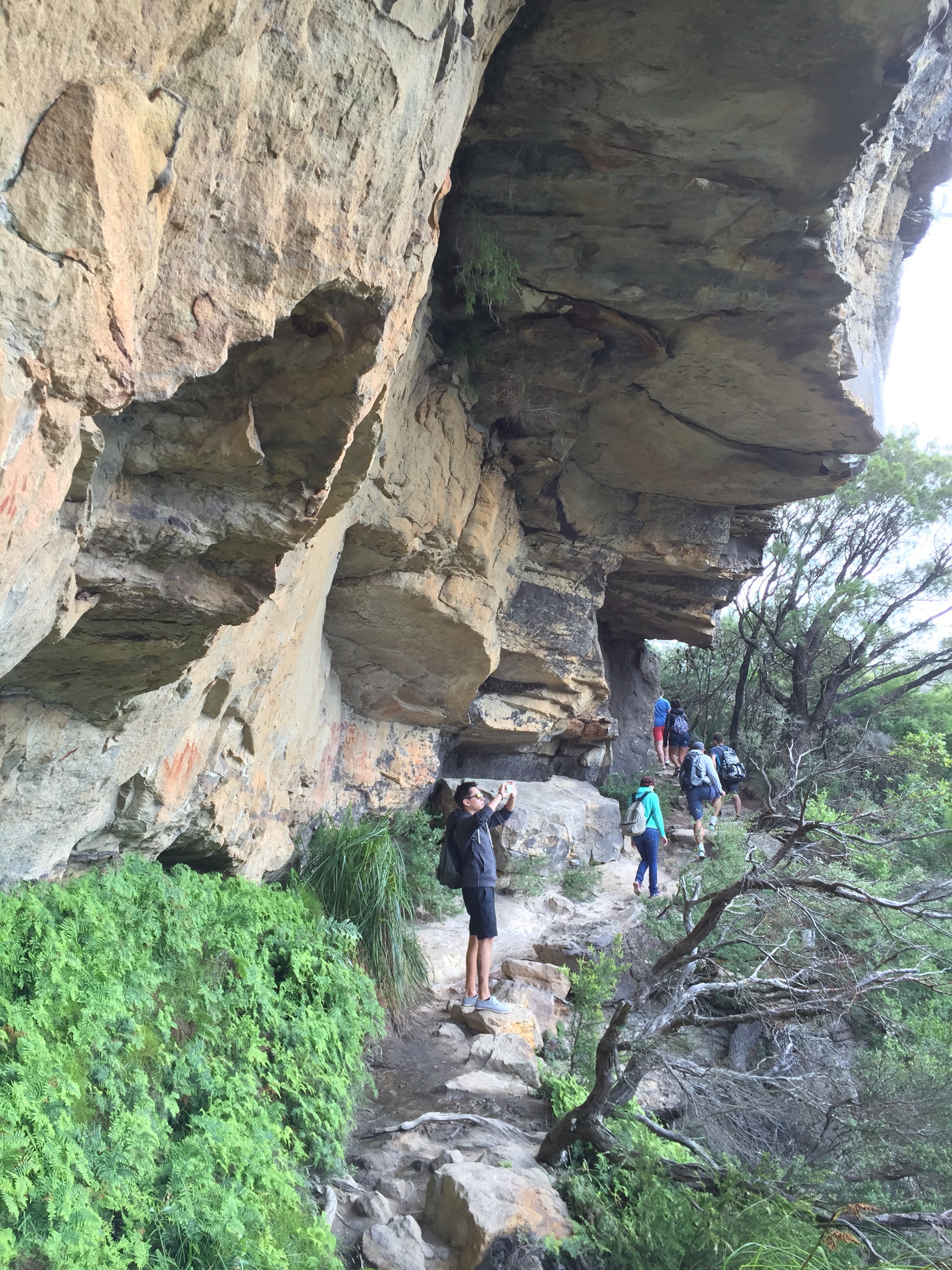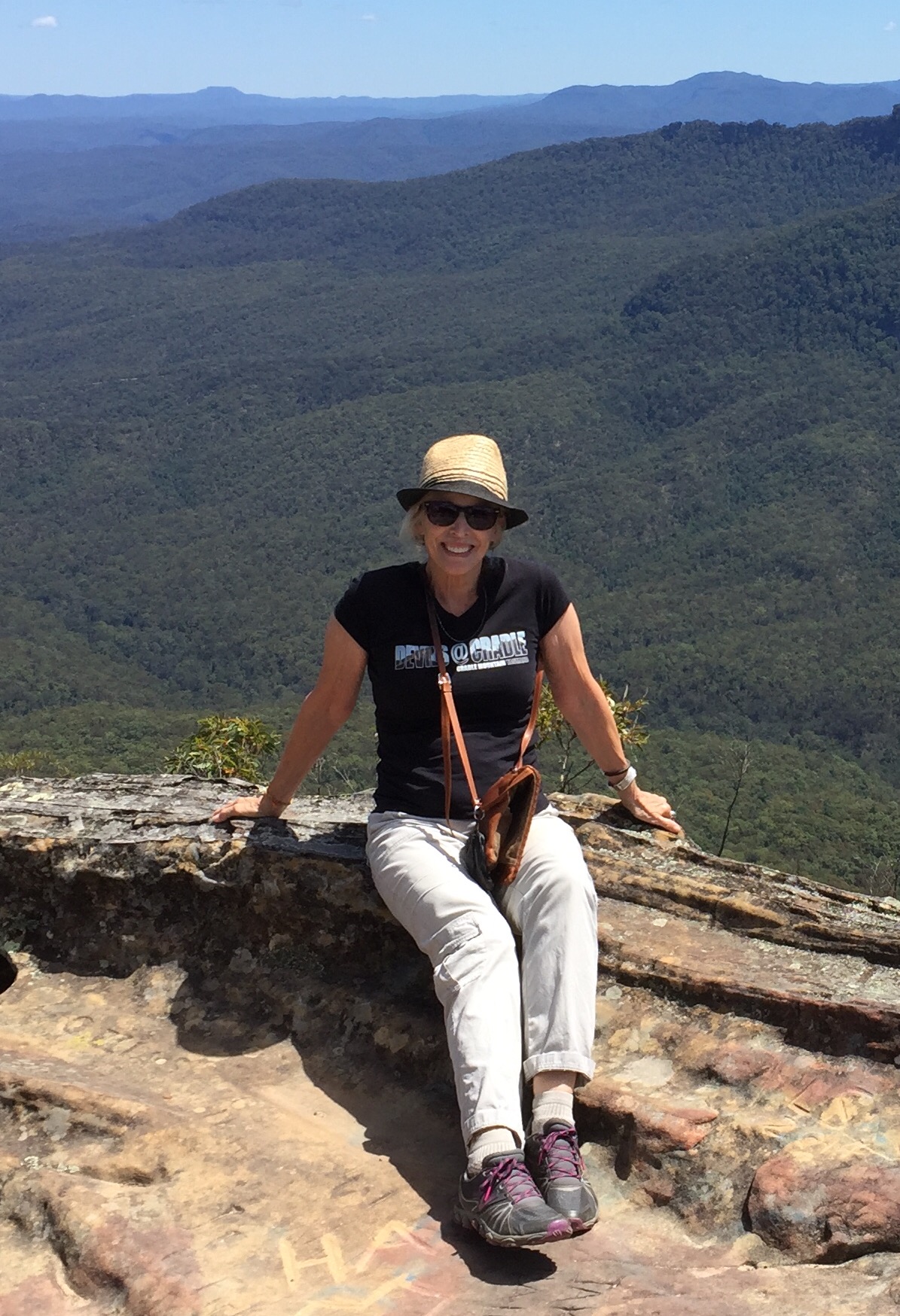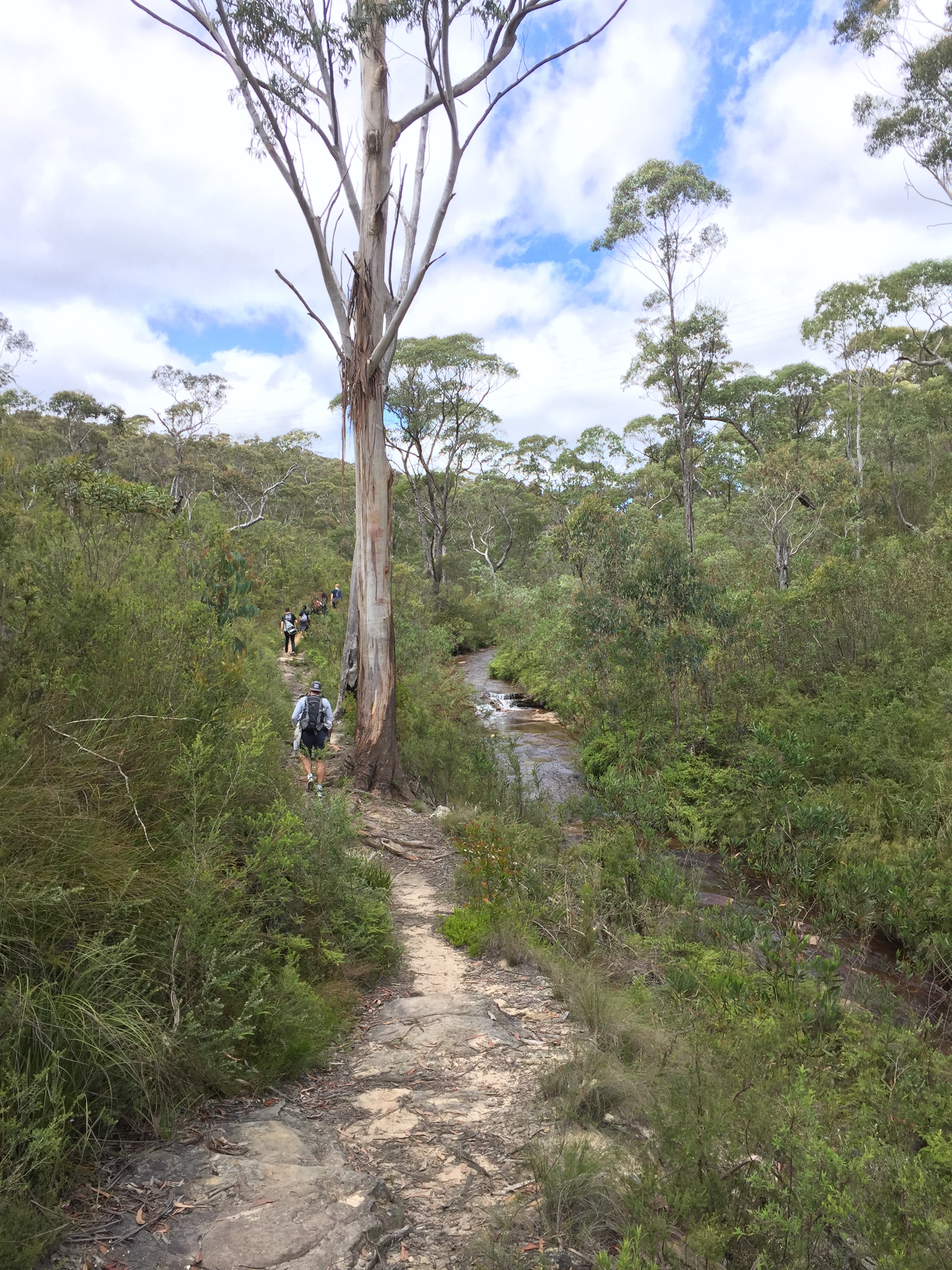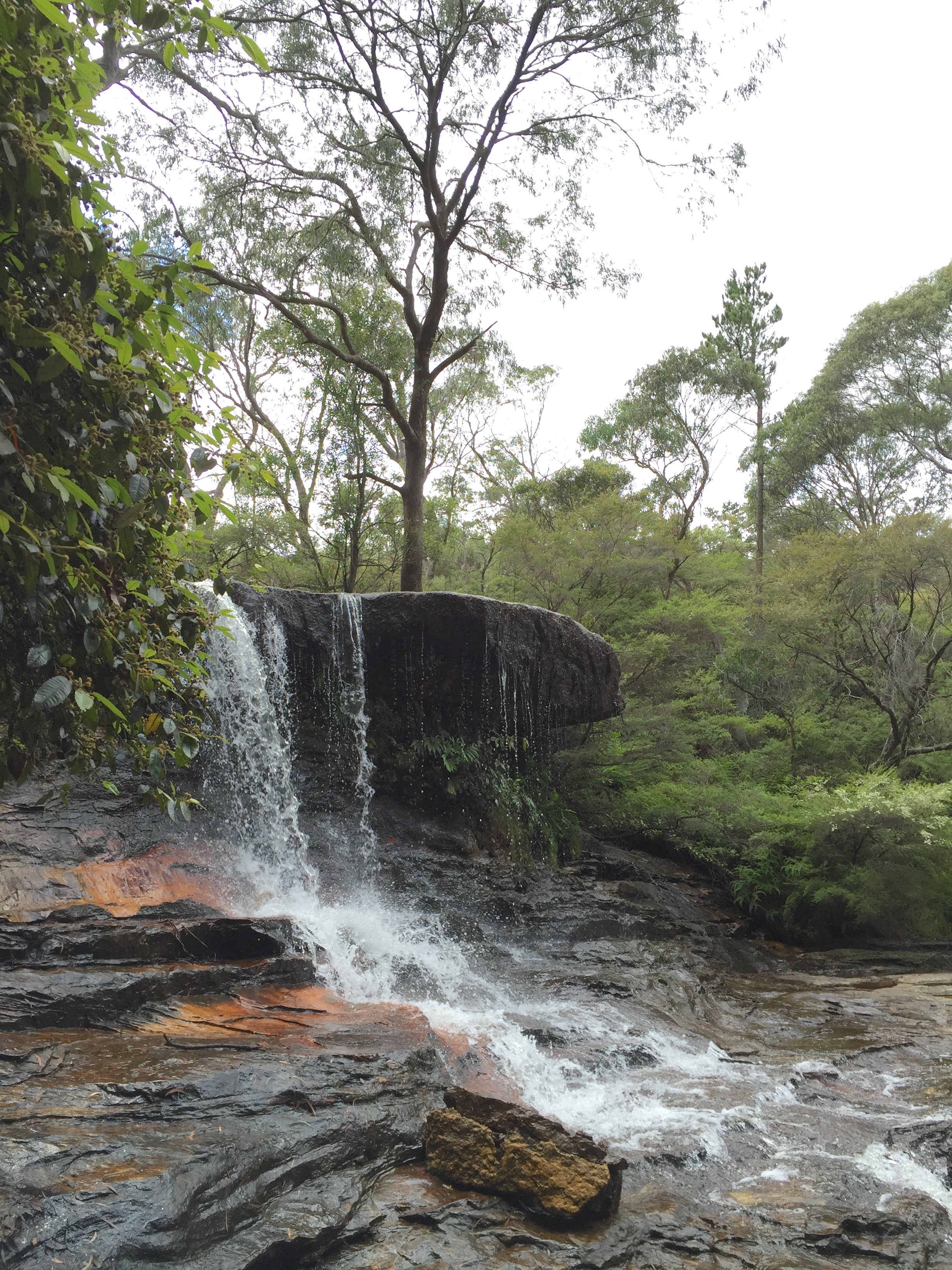by Betsy Herbert
March 2, 2016
"360 degree spin on Country," skateboards painted by Claudia Moodoonuthi, on display at the National Gallery in Melbourne, Australia
Just 10 days before, I was lazing on the beach in Phuket, Thailand, reflecting on my travels over the past three months in Africa and Asia. The next day I boarded a plane in Bangkok, headed for Perth, Australia.
Ah, Australia! I’d be able to drink tap water without worrying about getting sick. I was also looking forward to renting a car. In Africa and Asia, driving a rental car would have been suicidal for a Westerner.
When I got off the plane at Perth Airport just outside of Western Australia's capital city Perth, I wondered where all the people were. It was after midnight. I could see a sky full of stars above the terminal, but there were just a few folks milling around. I drew a deep breath in appreciation of this moment's solitude.
Switching gears. After two cacophonous months in densely populated India and Indochina, such moments of solitude are welcome. After a moment, I switched gears and flagged down a cab to take me to my AirBnB in downtown Perth about 30 minutes away.
My AirBnB host had arranged for the nightwatchman in the Apple Store across the street from the apartment to hand off the key to me when I arrived. I was somewhat apprehensive about how this would work out. After my taxi dropped me in front of the store at about 2:00 a.m., I waved through the window at the surly looking security guard inside at the back of the store. He walked slowly to the front and asked for my name. When I told him, he opened the thick glass door just a crack, and handed me the key to my apartment. After he watched me open the apartment door, we exchanged a brief thumbs-up. All of this happened in the middle of downtown Perth, with not another soul in sight.
After a restful night's sleep at the apartment, I felt ready to plan my trip to some remote areas of Australia I hadn't seen before. Decades ago, I’d lived in Australia for about seven months, so I’d visited Sydney, the Great Barrier Reef, Alice Springs, Uluru and Darwin.
Big plans. I decided to rent a small car and drive solo from Perth some 600 km north on Australia's spectacular west coast to Sharks Bay and Monkey Mia. I was looking forward to swimming with dolphins and seeing some unspoiled coastline.
With my plans in place to start my trip the next day to Sharks Bay, I set out on the town to explore the night life. I had a hankering for some chocolate. I hadn't yet found any in downtown Perth. I set out walking in the major bar area of Perth and soon saw a tall, man with a dark pony-tail leaning on the wall outside a bar. He was strikingly handsome in his jeans and white shirt. So I thought I'd ask him if there was anyplace nearby where I might find some chocolate.
He smiled, thought about it for a moment, and then laughed and said he couldn't think of any such place. I asked him if he was the bouncer. He said no, he was waiting to meet a group of folks who were celebrating a retirement. We conversed for awhile and then he invited me to go along with him to the retirement party. Just a very casual get together, he said, in the same complex of restaurants. So I gleefully accompanied him, met his friends, and we all ordered food and drinks in the restaurant. By the end of the evening, I knew all about the office politics, the work histories of everyone there, including my new friend Dale, who was a fisheries biologist. I was tempted to spend the rest of the evening with him, as he wanted to know more about my trip around the world. But I knew I had an early start the next day, so I bid the group farewell.
Often, that's the way travel goes. You meet someone, have a great conversation and then you move on. Still, these brief encounters can be unforgettable!
Up the Turquoise Coast to Nambung and Kilbarri National Parks.
The next morning I picked up my rental car in Perth and drove up Indian Ocean Road and Route 60, along Western Australia's sparsely populated Turquoise and Batavia coasts. The roads in these parts are well maintained and there is little traffic other than huge “road trains” of triple-trailer trucks.
Limestone columns rise from the yellow dunes of Pinnacles in Nambung National Park (photo by Betsy Herbert)
Nambung and Kilbarri National Parks. Countless turnouts allowed me to observe the astounding desert and coastal landscapes here. The Pinnacles rock formations in Nambung National Park rise out of bright yellow sand dunes.
Natural bridge at Kilbarri National Park, Western Australia (photo by Betsy Herbert)
Further north, the natural bridges of Kilbarri National Park rival those of Utah. But in this part of Australia, the red rocks contrast spectacularly with blinding-white sandy beaches and the crystal clear blue-green Indian Ocean. To add to the eye-candy, many of the shrubs of the coastal heath, including hakea and banksia were still blooming, thanks to some late spring rains.
I was saddened that the only kangaroos I saw on this trip were dead ones; the roadkill was shockingly plentiful. On one 50-kilometer stretch I saw at least 10 dead ‘roos on the side of the road. Almost every car in these parts has a hefty grill protector mounted across its front.
Northern Territory: Shark Bay and Monkey Mia. After another 400 kilometers, I crossed the 26th Parallel, which officially marks the boundary of Australia’s Northern Territory. Soon after, I reached Shark Bay, a World Heritage Area, where the world’s largest spread of sea grass provides wonderful habitat for dolphins, dugongs, loggerhead turtles, green sea turtles, tiger sharks, and manta rays, to mention a few well-known megafauna.
Monkey Mia, a beach at Sharks Bay, is renowned for its daily visits from wild bottlenose dolphins. The park rangers there can identify each individual dolphin by the scars and outline of its dorsal fin.
I took a half-day cruise on Shotover, a 60-foot racing catamaran, which is now used for sea life spotting expeditions in Shark Bay. Our boat was accompanied at times by pods of dolphins, most of whom first mate Kate knew by name. We also caught glimpses of dugongs and green sea turtles.
First mate Kate, aboard Shotover, a 60 foot catamaran, knows all the resident Shark Bay dolphins by name and by the unique shapes and scars on their dorsal fins.
Shark Bay is like a living laboratory where you can view the Earth’s oldest surviving organisms, the stromatolites at Hamelin Pool. Stromatolites are limestone structures resembling meter-wide cow pies. Each is formed over thousands of years by single-celled blue-green algae, which thrive in extremely salty water.
Though they’ve been around for some 3,500 million years, stromatolites still survive at Hamelin Pool only because of the high salinity of the bay here. These conditions are created by Shark Bay’s huge seagrass meadows, which form sand bars and shallow bays where water evaporates quickly in the hot dry climate allowing salt to build up.
Stromatolites at Hamelin Pool Conservation Center near Shark Bay in Western Australia. These ancient structures still survive here only because of the extremely salty conditions of the bay.
Perth
I returned to Perth after a week exploring the west coast. Perth is a great city to explore on your own. You can walk downtown and shop, and you can hike and bike in Perth's fabulous Kings Park, bordering both the harbor and downtown. Kings Park is home to the spectacular Western Australian Botanic Garden, which displays over 3,000 species of the state’s unique flora. With 1,003 acres it's one of the world's largest inner city parks, and one of the most beautiful. I especially enjoyed the elevated boardwalks, which allow you to walk through the forests canopy, while looking out over the harbor.
Many of the plants growing there are critically endangered. Signs along the paths point out the plant's habitat requirements as well as the threats to their existence.
A canopy boardwalk structure in Kings Park gives you a birds eye view of some of Western Australia's 3,000 native flora growing here in the botanical gardens.
Some of the native plants in bloom in the Kings Park botanical garden in Perth, Western Australia.
Perth architecture is a wonderful blend of old and new, and the contrast is sometimes incorporated in the same buildings. See below:
This government building in downtown Perth incorporates old and the new architectural styles, in an obvious and entertaining way.
I wanted to stay longer in Perth, but I was now bound for Melbourne for a few days before setting out on another solo drive around Australia's island state of Tasmania. I had originally planned to take the famous Indian Pacific train across the bottom of Australia to Melbourne, but because it was Christmas week, the only available seats were extremely expensive. So I flew.
Melbourne.
I arrived in Melbourne just in time to join all the last-minute Christmas shoppers near Federation Square. While it is easy to get around on public transportation, I had an AirBnb apartment in the Southbank area, which was walking distance to everything downtown.
Melbourne's public transportation system makes getting around the city fairly easy, but I walked almost everywhere from my apartment in Southbank.
My favorite place in Melbourne was the Ian Potter Gallery, National Gallery of Victoria. The gallery contains more than 70,000 pieces of historic indigenous art, contemporary art and artifacts. Viewers were allowed to photograph the works. I have displayed some of my photos of these works (see top photo) and below, with documentation from the gallery.
"Memory and Five Mile Creek," painting by Daisy Napaltjarri Jugadai, 1995. On display at the Ian Potter Gallery, NGV, Melbourne, Austraiia.
"Homelands," painting by Pantjiti Mary McLean, 1994 on display at the Ian Potter Gallery, NGV, Melbourne, Australia.
Onwards to Tasmania.
I'd always wanted to see the remote island Tasmania, a 35,000 square mile island just across the Bass Strait from Melbourne. Tasmania is known for its expansive and rugged wilderness areas, parks and reserves. It's also known for its 19th-century Port Arthur penal colony, which is now an open-air museum.
Once again, I decided to rent a car and drive around the island. Starting in the capital city of Hobart near the southeast corner of Tasmania, I would head northwest to Cradle Mountain, Lake St. Clair, and then on to the east coast town of Strahan.
I spent a couple of days exploring Hobart, a charming city with a small town feel. I drove to the top of Mt. Wellington just outside the city for spectacular views. It was also fun to know that Charles Darwin climbed this mountain in 1836 during his famous voyage on the HMS Beagle.
View of Hobart from Mt. Wellington, Tasmania.
Another pleasure was the Royal Tasmanian Botanical Garden, inside the Hobart city limits. While the garden features mostly plants native to Tasmania, I was pleased to find a specimen of California's Sequoia sempervirens, more commonly known as the coast redwood. The approximately 80-year old tree was obviously thriving in Tasmania's cool, foggy climate. The information sign next to the tree provided an interesting perspective:
"Confined to a narrow, humid, coastal belt in the USA, Coast Redwoods ar the tallest living trees in the world, the highest measured at 112.2 m (368 feet). They may live up to 1,000 years. The fibrous bark may be 30 cm thick, and the small, woody cones are only about the size of a grape. Native American Indians had long regarded the redwoods a sacred trees, but subsequent to the discovery by white Americans in the mid-nineteenth century, the beautiful durable red timber became highly sought after, resulting in heavy over-exploitation, and the former forests are now restricted to a few reserves."
It's always illuminating to get a foreign country's perspective on different aspects of American history and culture!
Lake St. Clair and Platypus Bay
My first stop after leaving Hobart was Lake St. Clair, where you can take a day hike through the forest to Platypus Bay, home to native populations of the duck-billed platypus. It was a lovely hike with lots of native eucalyptus and other trees, but unfortunately, I didn't see any platypus.
Platypus Bay on Lake St. Clair, central Tasmania, Australia. The region is home to the duck-billed platypus.
One of the trail signs explained how the indigenous people of Tasmania for thousands of generations had used fire to manage the grasslands and forests to supply food and habitat for native species. The entire ecosystem has evolved with these cultural practices, which indigenous people still use today in some of these areas.
Part of the native eucalyptus forest around Lake St. Clair, Tasmania, that was managed by indigenous people for thousands of generations using fire.
Strahan. After hiking around the trails of Lake St. Clair, I drove toward the west coast of Tasmania, where I would stay for a couple of days at the beautiful port city of Strahan, which sits on Macquarie Bay near the mouth of the Gordon River. Strahan used to serve as the port that shipped out the logs cut from the old-growth Huon pine forests along the Gordon River and to export ores mined from the mountains east of Strahan.
Strahan is a small village on the west coast of Tasmania and used to serve as a port exporting logs and ore from nearby natural areas. Today, it's primarily a tourist destination.
While the logging has stopped, the old-growth Huon pine forest was decimated. Today the Gordon River area is protected as a World Heritage site. I took a boat ride up the Gordon River and hiked in some of the forest, which is now recovering, though it takes more than 3,000 years for these trees to regrow to their previous state. Below are a few photos:
The Gordon River, part of the Franklin-Gordon Wilderness National Park and a World Heritage Sight, once was carpeted with 3,500 year old Huon pines, which were mostly logged. Today, the forests are recuperating in their protected state.
The old-growth Huon forest is mostly gone now, but it is recovering slowly.
Franklin-Gordon National Park Wilderness Area...dense undergrowth.
From Strahan, I drove to Cradle Mountain National Park, probably the most popular tourist destination in Tasmania. You can take a rigorous backpacking trip through the park, or take the day-hike around Dove Lake, which I did. It's a wonderful, not too strenuous trek on a constructed boardwalk trail. I saw few hikers when I went, and the views are spectacular. I've included some photos below:
The crystalline waters of Dove Lake, at the base of Cradle Mountain, Tasmania.
That's me on a day hike around Dove Lake, at the base of Cradle Mountain, Tasmania.
At Cradle Mountain, you can visit a government-sponsored conservation facility where the endangered Tasmanian Devil is cared for and bred. The mammal, endemic to Tasmania, has been decimated by a contagious cancer known as "Devil Facial Tumor Disease." Research is underway to detect the cause and find a cure for this scourge, which is always fatal, and has caused a precipitous decline in the Tasmanian Devil's population since it was first observed in 1996.
This is a Tasmanian Devil, endemic to Tasmania, now endangered due to a contagious cancer that causes fatal facial tumors. Efforts are underway to conserve and breed the animal in reserves like the one at Cradle Mountain, until a cure can be found for the disease.
I left Dove Lake bound for a town called Beauty Point near the Tamar River on the north coast of Tasmania where I would rest and write near a bird sanctuary known as the Redbill Point Conservation area.
This was a lovely, quiet resort of small trailers located near the sanctuary where you could walk and observe all kinds of birds. Photo below:
The Redbill Conservation Area in Beauty Point on the north coast of Tasmania is a quiet bird sanctuary.
Before heading back to Hobart to catch my flight to Sydney, I made one last stop along the way at Freycinet National Park on the east coast of Tasmania. This beautiful shoreline park is home to hooded plovers, red-capped plovers, pied oystercatchers and fairy terns. To protect the birds, the park is closed to vehicles and dogs. You have to take a rather strenuous half hour hike to reach Wineglass Bay, but it's definitely worth it!
Wineglass Bay at Freycinet National Park on the east coast of Tasmania is a protected spot for many native shorebirds including plovers.
On Christmas Day, I drove back to Hobart, turned in my rental car at the airport and caught my flight to Sydney. There I would meet up with some travel buddies I met in Indochina, watch the Sydney-Hobart Yacht race, and visit the Blue Mountains.
Sydney. Once again, I used AirBnb to find two apartments in Sydney where I stayed through New Year's Day. The first was directly across the harbor from the Sydney Opera House, though you had to peer through a metal stairwell for an obstructed view of the opera house from the apartment. I don't generally spend a lot of time in my room when I travel, so this wasn't a big deal. It's just that the flat was advertised on AirBnb as having a view of the opera house...kinda' misleading!
That said, this area of North Sydney is just great for walking around and for catching the ferries and all of the connecting trains. I found Sydney a joy to explore. I had to go check out Blues Point Tower, a huge apartment block where I rented a studio apartment decades ago when I worked in Sydney. The place has been converted to expensive condos now, and the whole area is lots more upscale than it was when I lived there. Glad I enjoyed the fabulous Sydney Harbor views when the price was right!
When I learned that the world famous Sydney-Hobart yacht race would take place during my stay in Sydney, I decided to watch it from the headlands at Sydney Harbour National Park, so I could watch the boats leave the harbor and head out to sea. I positioned myself at the highest point I could find, just below the lighthouse, and aimed my iPhone at the leaders as they approached the headlands. I got a terrific little video of Comanche taking the lead as she leaves the harbor. So I posted it on YouTube and within three days, the video received almost 7,000 views! It didn't hurt that Comanche won the race a few days later as she entered Hobart. See the video below:
The yacht race was a hard act to follow, but a trip to Blue Mountains National Park, just east of Sydney was just such an act. I signed up for a day trip, walked to the pick up point and got on the bus. Our guide was well informed, knew how to lead a group efficiently, and was very entertaining. There were about 12 of us on the bus, mostly young backpacker types, so I knew I would get some hiking in. What a great day, and beautiful weather. Photos below:
Scenes from Blue Mountains National Park, New South Wales, Australia:




Sydney on New Years Eve: My second apartment in Sydney had a view of the Harbour Bridge, the focal point of the over-the-top fireworks display on New Years Eve. I stayed home and watched the show from my window happily avoiding the massive crowds everywhere in the city within view of the bridge. It was, without a doubt, the best fireworks display I've ever seen.
View New Years Eve 2015 from my apartment window in Potts Point, Sydney. The fireworks were set off from various parts of the city, but the focal point was Harbour Bridge. You can see the silhouette of the Sydney Opera House, just in front of the bridge.
It was time to depart Sydney for my next destination New Zealand. On January 3, 2016 I bid a fond farewell to Australia. Here is my parting shot:
Nothing like a little didgeridoo music to connect with your inner outback!























